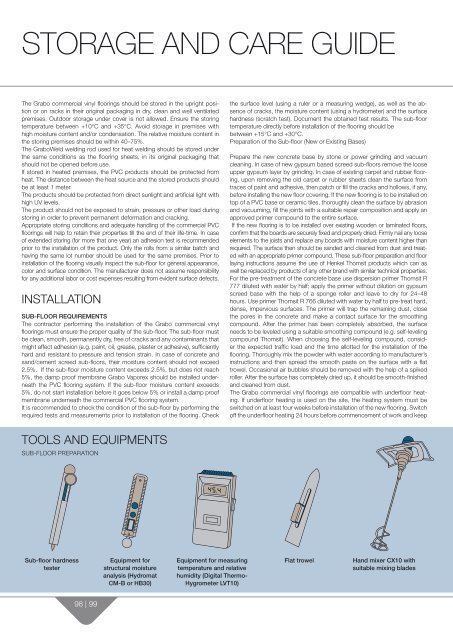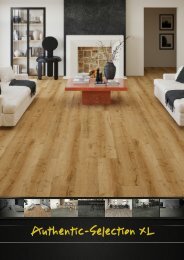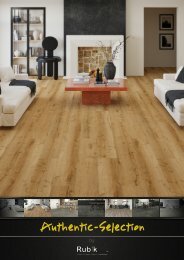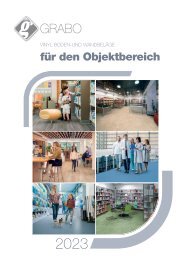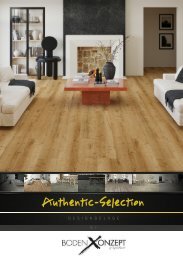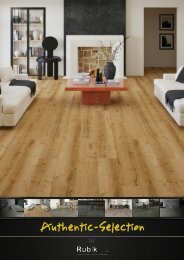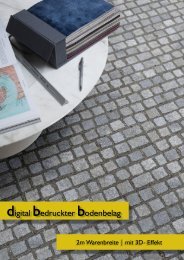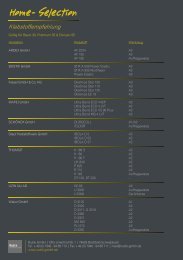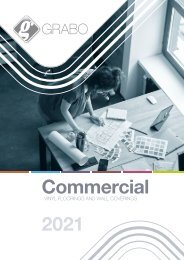Commercial 2018
Create successful ePaper yourself
Turn your PDF publications into a flip-book with our unique Google optimized e-Paper software.
STORAGE AND CARE GUIDE<br />
The Grabo commercial vinyl floorings should be stored in the upright position<br />
or on racks in their original packaging in dry, clean and well ventilated<br />
premises. Outdoor storage under cover is not allowed. Ensure the storing<br />
temperature between +10°C and +35°C. Avoid storage in premises with<br />
high moisture content and/or condensation. The relative moisture content in<br />
the storing premises should be within 40–75%.<br />
The GraboWeld welding rod used for heat welding should be stored under<br />
the same conditions as the flooring sheets, in its original packaging that<br />
should not be opened before use.<br />
If stored in heated premises, the PVC products should be protected from<br />
heat. The distance between the heat source and the stored products should<br />
be at least 1 meter.<br />
The products should be protected from direct sunlight and artificial light with<br />
high UV levels.<br />
The product should not be exposed to strain, pressure or other load during<br />
storing in order to prevent permanent deformation and cracking.<br />
Appropriate storing conditions and adequate handling of the commercial PVC<br />
floorings will help to retain their properties till the end of their life-time. In case<br />
of extended storing (for more that one year) an adhesion test is recommended<br />
prior to the installation of the product. Only the rolls from a similar batch and<br />
having the same lot number should be used for the same premises. Prior to<br />
installation of the flooring visually inspect the sub-floor for general appearance,<br />
color and surface condition. The manufacturer does not assume responsibility<br />
for any additional labor or cost expenses resulting from evident surface defects.<br />
INSTALLATION<br />
SUB-FLOOR REQUIREMENTS<br />
The contractor performing the installation of the Grabo commercial vinyl<br />
floorings must ensure the proper quality of the sub-floor. The sub-floor must<br />
be clean, smooth, permanently dry, free of cracks and any contaminants that<br />
might affect adhesion (e.g. paint, oil, grease, plaster or adhesive), sufficiently<br />
hard and resistant to pressure and tension strain. In case of concrete and<br />
sand/cement screed sub-floors, their moisture content should not exceed<br />
2.5%. If the sub-floor moisture content exceeds 2.5%, but does not reach<br />
5%, the damp proof membrane Grabo Vaporex should be installed underneath<br />
the PVC flooring system. If the sub-floor moisture content exceeds<br />
5%, do not start installation before it goes below 5% or install a damp proof<br />
membrane underneath the commercial PVC flooring system.<br />
It is recommended to check the condition of the sub-floor by performing the<br />
required tests and measurements prior to installation of the flooring. Check<br />
the surface level (using a ruler or a measuring wedge), as well as the absence<br />
of cracks, the moisture content (using a hydrometer) and the surface<br />
hardness (scratch test). Document the obtained test results. The sub-floor<br />
temperature directly before installation of the flooring should be<br />
between +15°C and +30°C.<br />
Preparation of the Sub-floor (New or Existing Bases)<br />
Prepare the new concrete base by stone or power grinding and vacuum<br />
cleaning. In case of new gypsum based screed sub-floors remove the loose<br />
upper gypsum layer by grinding. In case of existing carpet and rubber flooring,<br />
upon removing the old carpet or rubber sheets clean the surface from<br />
traces of paint and adhesive, then patch or fill the cracks and hollows, if any,<br />
before installing the new floor covering. If the new flooring is to be installed on<br />
top of a PVC base or ceramic tiles, thoroughly clean the surface by abrasion<br />
and vacuuming, fill the joints with a suitable repair composition and apply an<br />
approved primer compound to the entire surface.<br />
If the new flooring is to be installed over existing wooden or laminated floors,<br />
confirm that the boards are securely fixed and properly dried. Firmly nail any loose<br />
elements to the joists and replace any boards with moisture content higher than<br />
required. The surface then should be sanded and cleaned from dust and treated<br />
with an appropriate primer compound. These sub-floor preparation and floor<br />
laying instructions assume the use of Henkel Thomsit products which can as<br />
well be replaced by products of any other brand with similar technical properties.<br />
For the pre-treatment of the concrete base use dispersion primer Thomsit R<br />
777 diluted with water by half; apply the primer without dilution on gypsum<br />
screed base with the help of a sponge roller and leave to dry for 24–48<br />
hours. Use primer Thomsit R 766 diluted with water by half to pre-treat hard,<br />
dense, impervious surfaces. The primer will trap the remaining dust, close<br />
the pores in the concrete and make a contact surface for the smoothing<br />
compound. After the primer has been completely absorbed, the surface<br />
needs to be leveled using a suitable smoothing compound (e.g. self-leveling<br />
compound Thomsit). When choosing the self-leveling compound, consider<br />
the expected traffic load and the time allotted for the installation of the<br />
flooring. Thoroughly mix the powder with water according to manufacturer’s<br />
instructions and then spread the smooth paste on the surface with a flat<br />
trowel. Occasional air bubbles should be removed with the help of a spiked<br />
roller. After the surface has completely dried up, it should be smooth-finished<br />
and cleaned from dust.<br />
The Grabo commercial vinyl floorings are compatible with underfloor heating.<br />
If underfloor heating is used on the site, the heating system must be<br />
switched on at least four weeks before installation of the new flooring. Switch<br />
off the underfloor heating 24 hours before commencement of work and keep<br />
TOOLS AND EQUIPMENTS<br />
SUB-FLOOR PREPARATION<br />
Sub-floor hardness<br />
tester<br />
Equipment for<br />
structural moisture<br />
analysis (Hydromat<br />
CM-B or HB30)<br />
Equipment for measuring<br />
temperature and relative<br />
humidity (Digital Thermo-<br />
Hygrometer LVT10)<br />
Flat trowel<br />
Hand mixer CX10 with<br />
suitable mixing blades<br />
98 | 99


